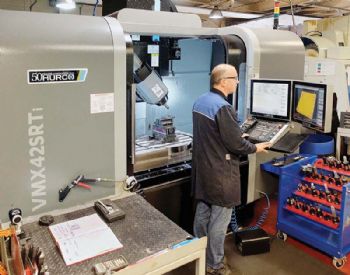
Having doubled the size of its premises in 2016 and bought its first five-axis machining centre — a Hurco VMX42SRTi with swivelling B-axis spindle — in the same year, Livingston-based sub-contractor Almond Engineering has now installed a second, similar model.
Managing director Chris Smith says he favours this style of five-axis machining centre over the trunnion-mounted rotary-table arrangement, due to its versatility for tackling a greater variety of work — including the four-axis machining of large components.
Last year saw Almond’s installation of a Hurco VMX30i; this was specified with a fourth-axis rotary table to shorten set-up times, increase production efficiency and reduce delivery times.
The company also bought a three-axis VMX60i; this has a 1,525 ¥ 660 ¥ 610mm work envelope that significantly increases the size of component that can be machined.
Almond’s overall equipment spend in 2018 exceeded £400,000, and half that amount is due to be spent again this year (this will include new software).
Driving this level of investment was 25% growth in 2016/17, a further increase in turnover the following year and a predicted 19% increase this financial year.
It is a pace that Mr Smith describes as “almost too fast”, considering the on-going difficulty of hiring skilled staff.
Much of Almond’s growth has come from winning new business from Scotland’s medical sector — for example, the assembly of production lines for contact lenses, and the machining of parts for operating-theatre equipment.
Medical now accounts for 8% of the company’s revenue by value.
Design input
Semiconductor firms in the central belt of Scotland are Almond’s other main source of revenue; contracts are also won from the aerospace and defence industries.
That said, a ‘hallmark’ of the company’s service is the significant amount of design work it puts into the mechanical-engineering aspects of the contracts it undertakes.
Celebrating its 40th anniversary this year, Almond now operates eight Hurco machine tools: a TM8 CNC lathe with an 8in chuck and seven machining centres that comprise most of the prismatic metal-cutting capacity on site (the only other machining centre is a Bohner & Koehle machine bought in the 1970s).

Commenting on his on-going purchase of Hurco machines, Mr Smith said: “Ours is a prototype and small-batch production environment, so efficient shopfloor programming is important to us. Indeed, we rely on it 90% of the time.
Back in 2004, we had a number of manual tool-change mills and one vertical machining centre, but we spent more time programming them than actually cutting metal.
To take over from them, in 2004 we bought our first VMX42, which had a 1m X axis.
The Hurco control was clearly ahead at the time in terms of the speed — and the capability of its conversational programming.
Indeed, I reckon this control has continued to lead the market ever since. “Moreover, we find the machines to be robust, reliable and accurate; we regularly hold ±0.01mm when cutting a wide variety of materials. These include Inconel and Hastelloy, as well as steels, aluminiums and plastics.”
Easy programming
Mr Smith also says that the user-friendliness of Hurco machines means his staff can move seamlessly between the twin-screen WinMAX controls powering the larger machining centres and the single-screen MAX controls on the smaller VM1 machining centre and TM8 lathe.
“As a result, our HyperMill offline CAM system is used mostly for programming more-complex 3+2-axis cycles, to reduce set-ups and improve accuracy on the five-axis machines — and to create some fully interpolative cycles.”

Organic growth at Almond has resulted in the number of employees increasing from 24 in 2011 to the current 37 (including three apprentices who were taken on recently).
The company also puts much effort into training the existing workforce and co-operating with local schools to promote engineering and the STEM subjects —science, technology, engineering and mathematics — with an eye to the future recruitment of employees and the expansion of the company.
Indeed, in June this year, it completed its first takeover, acquiring the trade and assets of Multex — another Livingston company; this will see turnover increase by a further 16%. Established in 1991, Multex designs and manufactures test equipment for electronic circuit boards; it also shares a number of customers with Almond.
A further benefit of the acquisition is the additional CNC and manual machining facilities that are available at the Multex site, giving both businesses increased capacity, flexibility and factory floor space.
No jobs were lost as a result of the acquisition, and an additional skilled appointment has already been made; more are anticipated.